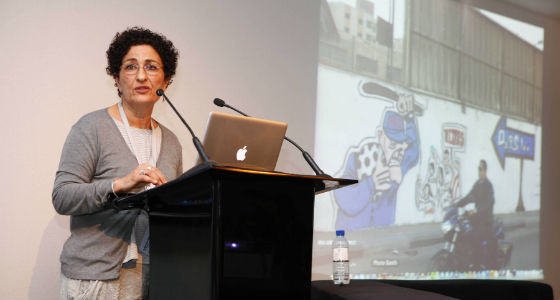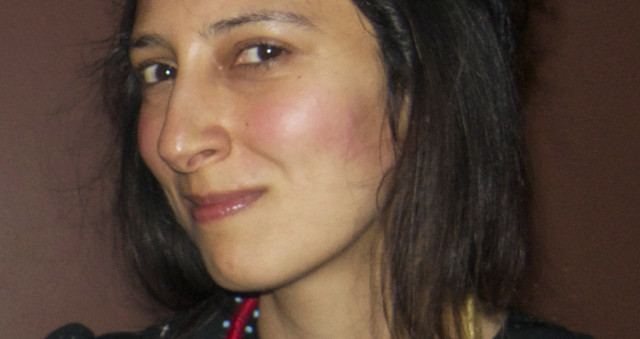
Cairo-based historian and artist, Huda Lufti, delivers the second reflection on media’s powerful role in recent and current political upheavals. (Photo courtesy Art Dubai)
It isn’t exactly a surprise that this year’s Global Art Forum, an annual discourse on contemporary art under the aegis of Art Dubai, should explore the theme “the Medium of the Media”. The event takes place on the rough anniversary of uprisings that spread across the Middle East, making it inevitable that panelists focused on where art fits into a landscape marked by tweets from Tahrir Square and the real-time dissemination of images of Qaddafi’s corpse.
This proved fruitful. Media, by virtue of its dual contexts within the worlds of reportage and publishing on the one hand, and as the agent of artistic expression on the other, has enough ambiguity to spawn rich discussions on the nebulous boundaries between information, art, and activism. This week, we’ll be covering a few of the most interesting of those discussions.

Journalist and Bidoun senior editor Negar Azimi posed a series of questions to spur reflection on the polemic: “What’—if anything—’is to be done’ by artists in the face of turbulent historical times when it’s the media, arguably, that possesses today’s power to shape our imaginations and ideologies the most?”
Concern over the brutal crackdown on Syrian revolutionaries and Egypt’s unpredictable political climate tempered the usual unabashed glamour at Art Dubai. At this stage of the game, many of the participants at Art Dubai’s Global Art Forum—the panel discussion contingent of the fair—preferred to pose questions rather than draw conclusions about the state of contemporary art in the Middle East.
“Is contemporary art up to the task of addressing complex social and political realities in the world around us? And should we demand this of art in the first place?” asks Negar Azimi, a journalist and Bidoun magazine editor, in a session entitled “Power less: Art vs Media.”
Underlying the discussion was the premise that media, particularly 24-hour news, has become the ultimate source of information on political change. In other words, has media eclipsed contemporary art as the zeitgeist? In the early part of the 20th Century, Ms. Azimi pointed out, art’s potential to inspire political agency was alive and well, the origin of both the anti-nationalist jeers of Dada and the propaganda of Guernica (a work commissioned by the Republican Spanish government). Has this now given way to official media coverage and citizen journalism?
And what of those innumerable images documenting every detail of the Arab street protests, captured and disseminated via personal devices from Manama to Tunis? Susan Sontag’s warning about the alienation and disengagement caused by the constant flux of horrifying photojournalistic images resonates with William Wells, director of Townhouse gallery in Cairo. He worries about the “volume of raw Youtube footage bombarding us every day.” But do any of these images rise to the level of art? Does labeling them as art alter their impact?
Yes, according to the Cairene artist and historian Huda Lutfi. She makes the case that the definition of what we consider art may be expanding so that some of what has been produced on the street does indeed constitute art, regardless of its formal qualities or the ‘artist’s’ background. In response to Ms. Azimi’s suggestion that these campaigns represent a new form of culture, Ms. Lutfi asks, “Why separate what these activists are doing from contemporary art?” Moreover, Ms. Lutfi believes art still has a potent role to play in spreading revolutionary messages and inspiring political activism. Fighting back tears at times, she credits the graffiti that popped up on police barricades throughout Cairo as instrumental in countering the government news agency’s anti-revolutionary propaganda.
Street art may be the most well-suited art form to communicate the spirit of the Egyptian revolution because, much like the nascent democratic movement, it faces the constant threat of being erased by the authorities. Moreover, street art is subject to taking on forms wildly different from what the artist intends, thanks to an added brush stroke here and there by an invisible hand in the middle of the night. Yet the very qualities that enable street art to embody the aspirations and challenges of the revolution also make it difficult to preserve. Ms. Azimi, for example, admits to losing interest in street art once it is brought within the walls of a gallery, though she acknowledges there are few other ways to document it. “It’s too early,” she says, “to make a coffee table book about the graffiti of the Egyptian revolution.”
As the discussion continues, the question of monetization comes into play. The notion that artists, gallerists, and even collectors might profit off the blood and tears of the Arab Spring is an uncomfortable thought. Nevertheless, the setting made it impossible to overlook: a mere stone’s throw away, at Art Dubai, a few enterprising galleries were already selling pieces marketed as “art of the revolution”. With moderate success, Ms. Lutfi tries to convince us that, as an artist herself, she does not consider it “problematic to produce works that express what I lived through the last year, as long as they are not monetized.” From her subsequent remarks, though, one surmises that she is still grappling with this idea: “But then, what do you do with the art if you can’t sell it?” she asks herself aloud. At issue, the panelists concur, is how to differentiate between artists who are opportunistic and those who are sincere.
Mr. Wells interjects, inferring it might not yet be time to worry about that. In face of “economic, political, and humanitarian crises across the globe,” he wonders: “What is art for? Does it matter? Is a painting more powerful than a photograph of a murder victim? Is it more truth-telling?” Neither the other panelists nor any audience member could offer a satisfying response.


{ 1 comment }
This is pretty serious if you think about the implications, Art has been about politics since, like, forever. Will the digital ehistory books of the future only have youtube videos instead of works of art?
Comments on this entry are closed.